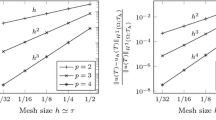Abstract
We formulate and analyze new methods for the solution of a partial integrodifferential equation with a positive-type memory term. These methods combine the finite element Galerkin (FEG) method for the spatial discretization with alternating direction implicit (ADI) methods based on the Crank–Nicolson (CN) method and the second order backward differentiation formula for the time stepping. The ADI FEG methods are proved to be of optimal accuracy in time and in the \(L^2\) norm in space. Furthermore, the analysis is extended to include an ADI CN FEG method with a graded mesh in time for problems with a nonsmooth kernel. Numerical results confirm the predicted convergence rates and also exhibit optimal spatial accuracy in the \(L^{\infty }\) norm.
Similar content being viewed by others

References
Bramble, J.H., Ewing, R.E., Li, G.: Alternating direction multistep methods for parabolic problems-iterative stabilization. SIAM J. Numer. Anal. 25, 904–919 (1989)
Chen, C., Shih, T.: Finite Element Methods for Integrodifferential Equations. World Scientific, Singapore (1998)
Dendy Jr, J.E.: An analysis of some Galerkin schemes for the solution of nonlinear time-dependent problems. SIAM J. Numer. Anal. 12, 541–565 (1975)
Fernandes, R.I., Bialecki, B., Fairweather, G.: Alternating direction implicit orthogonal spline collocation methods for evolution equations. In: Jacob, M.J., Panda, S. (eds.) Mathematical Modelling and Applications to Industrial Problems (MMIP-2011), pp. 3–11. Macmillan Publishers India Limited, India (2012)
McLean, W., Mustapha, K.: A second order accurate numerical method for a fractional wave equation. Numer. Math. 105, 481–510 (2007)
McLean, W., Thomée, V.: Numerical solution of an evolution equation with a positive-type memory term. J. Aust. Math. Soc. Ser. B. 35, 23–70 (1993)
McLean, W., Thomée, V.: Numerical solution via Laplace transforms of a fractional-order evolution equation. J. Integral Equ. Appl. 22, 57–94 (2010)
McLean, W., Thomée, V.: Maximum-norm error analysis of a numerical solution via Laplace transformation and quadrature of a fractional-order evolution equation. IMA J. Numer. Anal. 30, 208–230 (2010)
McLean, W., Thomée, V., Wahlbin, L.B.: Discretization with variable time steps of an evolution equation with a positive type memory term. J. Comput. Appl. Math. 69, 49–69 (1996)
Mustapha, K., McLean, W.: Discontinuous Galerkin method for an evolution equation with a memory term of positive type. Math. Comput. 78, 1975–1995 (2009)
Pani, A.K., Fairweather, G., Fernandes, R.I.: Alternating direction implicit orthogonal spline collocation methods for an evolution equation with a positive-type memory term. SIAM J. Numer. Anal. 46, 344–364 (2008)
Thomée, V.: A high order parallel method for time discretization of parabolic type equations based on Laplace transformation and quadrature. Int. J. Numer. Anal. Model. 2, 85–96 (2005)
Wheeler, M.F.: A priori \(L_2\) error estimates for Galerkin approximations to parabolic partial differential equations. SIAM J. Numer. Anal. 10, 723–759 (1973)
Acknowledgments
The authors AKP and GF gratefully acknowledge the research support of the Department of Science and Technology, Government of India, through the National Programme on Differential Equations: Theory, Computation and Applications, DST Project No.SERB/F/1279/2011-2012. Support was also received by AKP from Chiangmai University, Thailand, and by GF from IIT Bombay while a Distinguished Visiting Professor at that institution.
Author information
Authors and Affiliations
Corresponding author
Appendices
Appendix 1
Lemma 7.1
With \(\zeta _{n}=k_{n+1}/{k_n}\),
Proof
First recall that, for \(a, b \in \mathcal{R}\),
With
we have
or
With \(t_n=(nk)^{\gamma }\),
and
Thus
on using (7.1). Then, from (7.2),
Thus
Since
it follows that
Then using (7.3) again,
which completes the proof.\(\square \)
Appendix 2
For any continuous function \(\psi \),
from the midpoint rule. Thus, if
then
where
Rights and permissions
About this article
Cite this article
Khebchareon, M., Pani, A.K. & Fairweather, G. Alternating Direction Implicit Galerkin Methods for an Evolution Equation with a Positive-Type Memory Term. J Sci Comput 65, 1166–1188 (2015). https://doi.org/10.1007/s10915-015-0004-9
Received:
Revised:
Accepted:
Published:
Issue Date:
DOI: https://doi.org/10.1007/s10915-015-0004-9
Keywords
- Partial integrodifferential equation
- Positive-type memory term
- Finite element Galerkin method
- Alternating direction implicit methods
- Optimal error estimates
- Smooth and nonsmooth kernels


